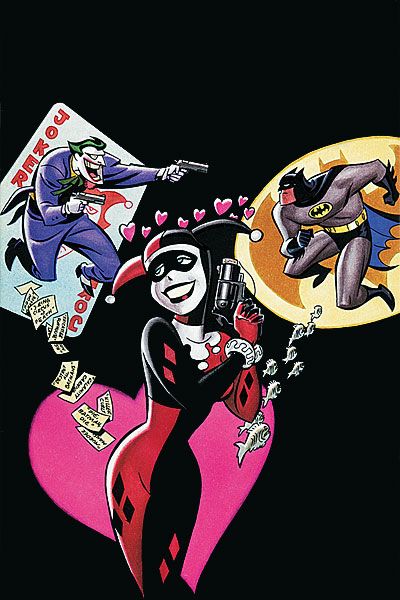Though I'm here to talk about the contents of this volume, I can't help but point out that for $19.99, you get over 200 pages of slickly-reproduced Batman comics in a sturdy hardcover collection. Even if these were just mediocre Batman stories, that would be a pretty good deal, right? 10 cents per page, basically? These days, you're paying about 15 cents a page for mediocre comics all the time, and that's just for the non-hardcover floppies. And how many of those comics feature work by the man-who-saved-1990s-Batman, Bruce Timm?
Timm, as I'm sure you know, was an instrumental figure in the creation of "Batman: The Animated Series" and shepherded nearly the entire DC line through a Golden Age of Superhero animation in the 1990s and early 2000s. Timm's Jack Kirby-by-way-of Chuck Jones's style has lost its freshness over the years, as hundreds of episodes (and even more comic books from the Johnny DC line) have turned his dynamic visual approach into a house style. But there's no disputing the fact that Timm reinvigorated the Batman franchise at a time when the "mainstream" Batman comics were wallowing in murky, humorless violence.
Because Timm's comic book work, done in collaboration with animation-writer-turned recent "Detective Comics" scribe Paul Dini, was most often targeted at kids, many fans probably skipped the comics reprinted in this volume. It's no wonder that DC released this hardcover with Dini and Timm's name featured prominently on the cover and nary a Johnny DC logo to be seen. This is good stuff that would appeal to anyone.
The feature story, "Mad Love" originally appeared as a prestige format one-shot and tells the definitive Harley Quinn story. Later adapted into an episode of the animated series, "Mad Love" shows Harley at her most desperate, trying to impress her beloved Joker by killing Batman for him. In the story, we also learn the secret origin of Harley Quinn -- how she was once the Joker's psychologist but her obsession with him led her down the path of insanity -- and we get some surprisingly "adult" sexuality from the characters, though nothing that wouldn't be allowed on the animated series, from what Timm says in his "Afterword."
It's a good-looking story, drawn by Timm in a modified nine-panel-grid style, and it's certainly worth reading.
But it's not the best story in this excellent collection.
The best story would be the reprint of "Batman Adventures Annual" #1, which features a script by Dini, a framing sequence drawn by Timm, and a series of villain-gone-straight-but-not-really vignettes by artists like Mike Parobek, Dan DeCarlo, and Klaus Janson. The Dini/Parobek Ventriloquist story, in particular, is a great one. And there's also a manic back-up story about the Joker drawn by John Byrne in a style that's halfway between his "What The--?!" style and his current one. But that Dini/Parobek story is the one to remember.
And, surprisingly, as good as Timm is on his contributions to this book, the best drawn story actually comes from the pencils of animator Glen Murakami. Timm inks the story with nice, thick brush strokes, but it's Murakami (or Timm aping Murakami, as he reveals in the "Afterword") who provides the layouts and pencil art for the dynamic Batman/Demon/Ra's Al Ghul showdown from "Batman Adventures Annual" #2. The story isn't the best, but the art -- all 48 pages of which was done in less than three weeks -- is the highlight of this volume, and the Murakami/Timm team were absolutely born to drawn Jack Kirby characters, which there's no shortage of in this story.
"Batman: Mad Love and Other Stories" includes a few other Paul Dini/Bruce Timm short stories as well, featuring such characters as Poison Ivy, Batgirl, Clayface, and Two-Face, thus making it an appropriately comprehensive edition of their collaborative efforts. And, even if you ignore their great contributions to the DC animated universe and based your judgment on the stories presented here, you would be hard-pressed to deny that they deserve such a handsome collected edition.

